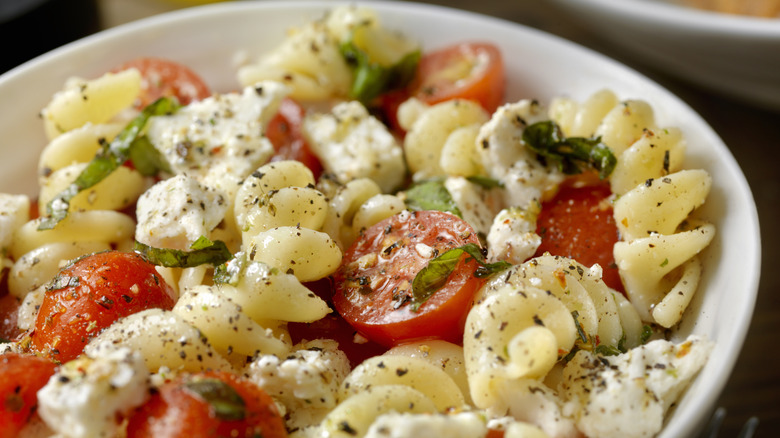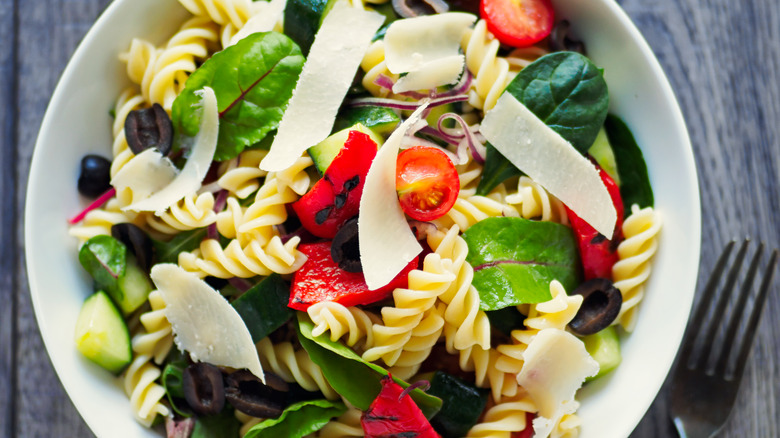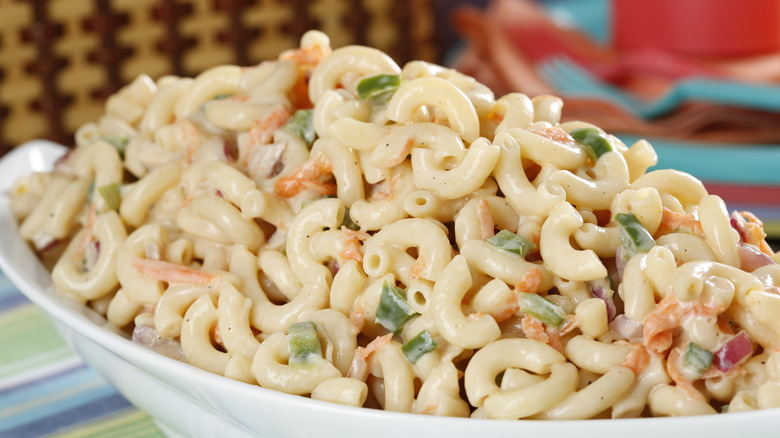The Difference That Separates Pasta Salad From Macaroni Salad
Summer is the season for backyard cookouts, poolside gatherings, and other potluck-type endeavors. Chances are that there will be a pasta salad or two present, be it the creamy, mayo-y macaroni salad or the picante savory style, possibly with bowtie pasta flare. Before you go to your next social event with a bowl of your favorite pasta side dish, consider for a moment the difference that separates pasta salad from its macaroni counterpart and impress your friends with a little food trivia.
For starters, pasta is the main ingredient in both dishes. Simply put, a macaroni salad is a pasta salad made with elbow macaroni pasta, the star of the show. But a pasta salad in its own right takes on a whole new meaning. Served cold or at room temperature, pasta salads can be made with any type of pasta or mixture of pastas, but traditionally a short, shaped pasta is best. Pasta salads contain a variety of typically savory ingredients, such as cured meats, hard or semi-soft cheeses, olives, nuts, beans, legumes, or sun-dried tomatoes dressed in oil or vinegar.
On the creamier side, traditional macaroni salad typically contains diced onions, celery, and possibly hard boiled egg, pickles or relish, bell peppers, or parsley (depending on what region you hail from), all tossed in a mayonnaise based mixture, which may or may not contain mustard, vinegar, or sugar.
The origin of pasta salad
The origin of pasta salad is unclear. However, some food historians believe the dish has Italian Jewish roots. Cookbook author and blogger Marcia Friedman (via The Nosher) explains that pasta salad was an Italian Jewish dish that provided a creative way to enjoy pasta on Shabbat. Macaroni salad, on the other hand, is distinctly American. However, variations can be found in countries including Australia and New Zealand, as well as regionally throughout the United States. But how did this oddly shaped pasta earn its place in American food heritage?
An Italian staple, pasta is traditionally made of durum wheat and water or egg. Spanish explorers are thought to have brought the food item to the New World in the 15th and 16th centuries. It wasn't until Thomas Jefferson returned from his sojourn in Europe in 1789 and brought back with him a "macaroni machine" (and an affinity for pasta of all shapes and sizes) that the pantry staple gained in popularity. In 1937, Kraft launched its boxed macaroni and cheese featuring its signature processed cheese, and a macaroni star was born.
Some of the earliest recipes for macaroni salad date back to 1914, although the original recipes looked much different than today's versions. However, the dish still reigns as an American classic.
Variations on pasta salad
Macaroni salad has Southern roots, but regional variations abound. Some recipes call for the addition of bell peppers, carrots, red onions, and pickles, while others call for sweet relish, green onions, paprika, and parsley. A classic Southern macaroni salad recipe is loaded with mayo, celery, onions, chopped hard boiled egg, sweet pickles, and a hint of sugar. The velvety creaminess of the mayonnaise, combined with the sweet and tangy flavors, tie everything together. Toss on a little paprika, and you've created a Southern side-dish masterpiece.
Hawaiian macaroni salad, on the other hand, typically features shredded carrots and a sweet and tangy Hellmann's (or Best Foods, depending on where you're located) mayonnaise-based sauce made with milk, sugar, and vinegar. You'll find this version of macaroni salad served at luaus and in restaurants across the Hawaiian islands; its straightforward ingredients and creaminess are sure to be a hit.
As for pasta salad, the sky's the when it comes to ingredients. Keep things fresh and simple with a summer-picnic inspired cucumber and dill pasta salad recipe, or impress your friends with a loaded Mediterranean pasta salad recipe. Regardless of the occasion, pasta salad is always a safe choice. Why not try your hand at a dish that's sure to please even the finickiest of eaters?


